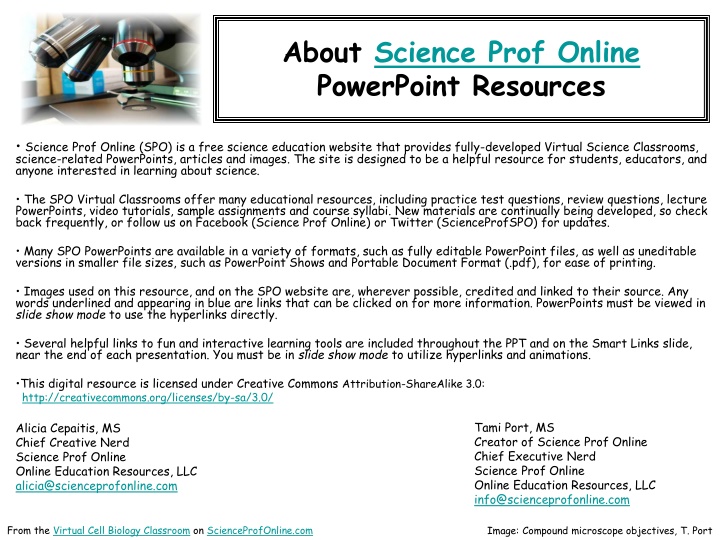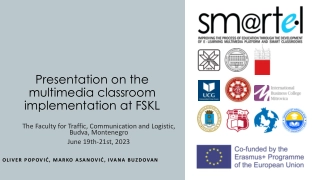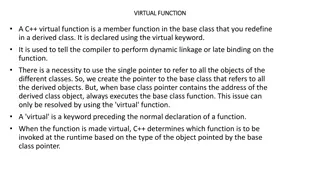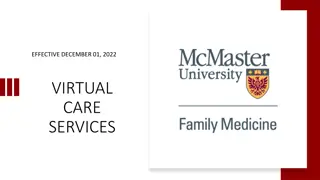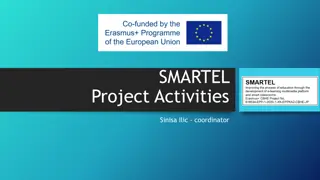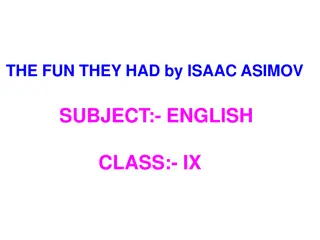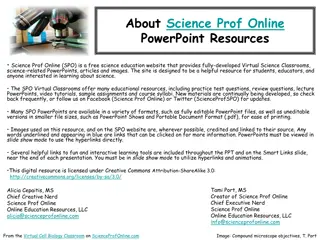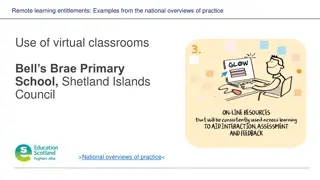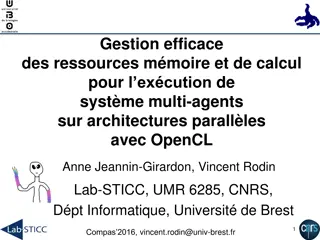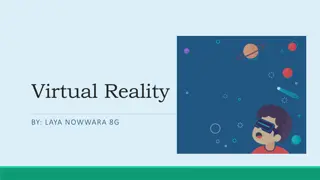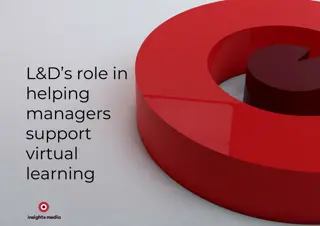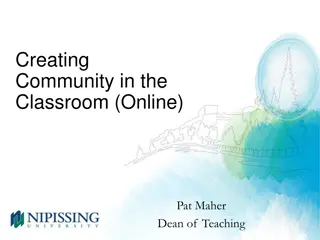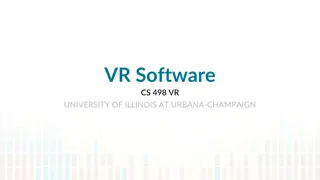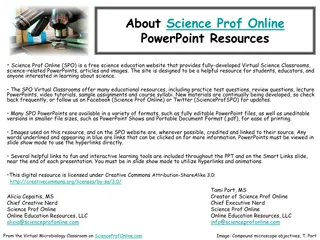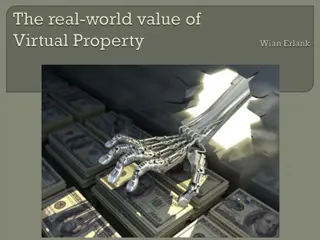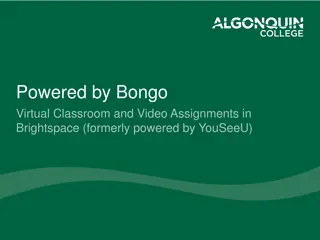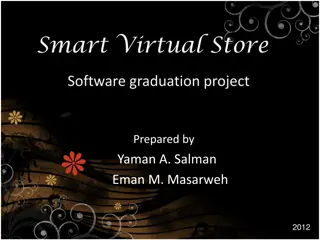Free Virtual Science Classrooms by Science Prof Online
Science Prof Online (SPO) is a valuable science education website offering fully-developed Virtual Science Classrooms for free. Users can access a wide range of educational resources to enhance their learning experience.
Download Presentation

Please find below an Image/Link to download the presentation.
The content on the website is provided AS IS for your information and personal use only. It may not be sold, licensed, or shared on other websites without obtaining consent from the author.If you encounter any issues during the download, it is possible that the publisher has removed the file from their server.
You are allowed to download the files provided on this website for personal or commercial use, subject to the condition that they are used lawfully. All files are the property of their respective owners.
The content on the website is provided AS IS for your information and personal use only. It may not be sold, licensed, or shared on other websites without obtaining consent from the author.
E N D
Presentation Transcript
About Science Prof Online PowerPoint Resources Science Prof Online (SPO) is a free science education website that provides fully-developed Virtual Science Classrooms, science-related PowerPoints, articles and images. The site is designed to be a helpful resource for students, educators, and anyone interested in learning about science. The SPO Virtual Classrooms offer many educational resources, including practice test questions, review questions, lecture PowerPoints, video tutorials, sample assignments and course syllabi. New materials are continually being developed, so check back frequently, or follow us on Facebook (Science Prof Online) or Twitter (ScienceProfSPO) for updates. Many SPO PowerPoints are available in a variety of formats, such as fully editable PowerPoint files, as well as uneditable versions in smaller file sizes, such as PowerPoint Shows and Portable Document Format (.pdf), for ease of printing. Images used on this resource, and on the SPO website are, wherever possible, credited and linked to their source. Any words underlined and appearing in blue are links that can be clicked on for more information. PowerPoints must be viewed in slide show mode to use the hyperlinks directly. Several helpful links to fun and interactive learning tools are included throughout the PPT and on the Smart Links slide, near the end of each presentation. You must be in slide show mode to utilize hyperlinks and animations. This digital resource is licensed under Creative Commons Attribution-ShareAlike 3.0: http://creativecommons.org/licenses/by-sa/3.0/ Tami Port, MS Creator of Science Prof Online Chief Executive Nerd Science Prof Online Online Education Resources, LLC info@scienceprofonline.com Alicia Cepaitis, MS Chief Creative Nerd Science Prof Online Online Education Resources, LLC alicia@scienceprofonline.com From the Virtual Cell Biology Classroom on ScienceProfOnline.com Image: Compound microscope objectives, T. Port
Chemical Bonds, Reactions & Notation Making Molecules & Compounds Image: Combustion Reaction of Methane, Wiki From the Virtual Cell Biology Classroom on ScienceProfOnline.com
Elements, Atoms, Molecules & Compounds Elements Substances that can t be broken down any further. Atom The smallest unit of an element. Two or more atoms joined together chemically: Molecule Molecule containing at least two different Elements: Compound Examples of molecules:Carbon dioxide (CO2)and methane (CH4) , molecular hydrogen (H2), molecular oxygen (O2) and molecular nitrogen (N2). Examples of compounds: Only molecules containing two or more elements, such as carbon dioxide (CO2)and methane (CH4). Q: Explain why all compounds are molecules but not all molecules are compounds. Image: Periodic Table of Elements; Water Molecule, Wiki From the Virtual Biology Classroom on ScienceProfOnline.com
Mixtures & Compounds mixture= Physical combination of two or more pure substances. compound= Chemical combination of two or more pure substances in a fixed, definite proportion. Watch Video: Mixture vs Compound Example: Mixture - Iron & Sulfur Iron filings may be mixed with powdered sulfur in any proportion. The two components are easily separated by means of a magnet, The magnet will draw out the iron from the mixture. The components of a mixture usually can be separated by physical means such as distillation, evaporation, etc. 2004-04 Compound Iron sulfide (Pyrite or Fools Gold) However, if: a. seven parts iron filings or powder are mixed with four parts powdered sulfur b. mixture is heated to a red glow c. iron and sulfur form a compound - iron sulfide; chemically combined, not readily separated. From the Virtual Cell Biology Classroom on ScienceProfOnline.com
Remind me why we care about these valence electrons The electrons in an atom are located in shells at different energy levels. Electrons in the highest energy level are called valence electrons. Number of valence electrons governs an atom s bonding behavior. Q: What is the max number of valence electrons for a full valence shell? Atoms are much more stable, or less reactive, with a full valence shell. By moving electrons, the two atoms become linked. This is known as chemical bonding. This stability can be achieved one of two ways: -Ionicbond - Covalent bond From the Virtual Cell Biology Classroom on ScienceProfOnline.com Images: Carbon, Universe Today Website
Three Main Types of Chemical Bonds: 1. Ionic 2. Covalent 3. Hydrogen Image: Formation of ionic sodium fluoride, Wdcf; Methane Covalent Bonds, Dynablast, Wiki; DNA Chemical Structure, Madprime, Wiki From the Virtual Cell Biology Classroom on ScienceProfOnline.com
IonicBonds Involves transfer of electrons between two atoms. Found mainly inorganic compounds. Ion= an atom or group of atoms which have lost or gained one or more electrons, making them negatively or positively charged. Q: What are positively charged ions (+) called? Q: What are negatively charged ions (-) called? From the Virtual Cell Biology Classroom on ScienceProfOnline.com Images: Sodium Chloride, University of Winnepeg
Ionic compounds are made of oppositely charged ions Ionic Bonds are atoms held together by attraction between a (+) and a ( ) ion Compound is neutral overall, but still charged on the inside. Makes solid crystals (salts). From the Virtual Cell Biology Classroom on ScienceProfOnline.com Images: Halit crystal, Crystal structure of NaCl, Wiki
Reactions Involving Ions Remember ion = an atom which has lost or gained one or more electrons, so it s negatively or positively charged. The Principle of ion exchange is a common water softening method. From the Virtual Cell Biology Classroom on ScienceProfOnline.com
From the Virtual Cell Biology Classroom on ScienceProfOnline.com Lets use a Branganalogy to help us Understand the Concept of Ion Exchange 1. Brad Pitt is a negatively charged resin bead 2. Jennifer Anniston is a positively charged Sodium Ion 3. Angelina Jolie is a positively charged Calcium Ion - - Now lets say that positiveness equates with drop-dead gorgeousness Na+ - - - Ca++ - - Na+ - Ca++ - - - - - Negatively charged Brad is attracted to reasonably positive Jennifer. - Na+ Negatively charged Brad lets go of reasonably positive Jennifer in the presence of insanely positive Angelina. - -
Importance of Ions/Electrolytes in the Body: K+ ,Na+, Cl- Carry electrical impulses in the nervous system Maintain cellular function with the correct concentrations electrolytes Watch This! Brawndo Video Clip from movie Idiocracy. Image: Motor neuron, Wiki From the Virtual Biology Classroom on ScienceProfOnline.com
Three Main Types of Chemical Bonds: 1. Ionic 2. Covalent 3. Hydrogen Image: Formation of ionic sodium fluoride, Wdcf; Methane Covalent Bonds, Dynablast, Wiki; DNA Chemical Structure, Madprime, Wiki From the Virtual Cell Biology Classroom on ScienceProfOnline.com
CovalentBonds Involves the sharing of a pair of electrons between atoms. One covalent bond = 1 pair of shared electrons Covalent Compounds can make single (2 electrons), double (4 electrons) or even triple bonds (6 electrons) depending on the number of electrons they share. Found mainly organic compounds From the Virtual Cell Biology Classroom on ScienceProfOnline.com Image: Methane Covalent Bonds, Dynablast, Wiki
Polar vs. Non-Polar Covalent Bonds Non-polar molecules have electrons equally shared between their atoms. Polar molecules unequally share electrons between atoms, so have a slight positive charge at one end and a slight negative charge at the other. Image: Polar water molecule, Non-polar methane molecule, Wiki From the Virtual Biology Classroom on ScienceProfOnline.com
Oxidation - Reduction Reactions Or Redoxreaction = chemical reactions in which electrons are gained, lost (Q: What kind of bond?) or shared(Q: What kind of bond?) in a chemical reaction. oxidation: loss of electrons by a molecule, atom or ion. reduction: gain of electrons by a molecule, atom or ion. From the Virtual Cell Biology Classroom on ScienceProfOnline.com
Oil Rig From the Virtual Cell Biology Classroom on ScienceProfOnline.com Image: Oil Rig Platform, Nasa
Three Main Types of Chemical Bonds: 1. Ionic 2. Covalent 3. Hydrogen Image: Formation of ionic sodium fluoride, Wdcf; Methane Covalent Bonds, Dynablast, Wiki; DNA Chemical Structure, Madprime, Wiki From the Virtual Cell Biology Classroom on ScienceProfOnline.com
Hydrogen Bonds Hydrogen Bonds: When an atom of hydrogen is attracted to another electronegative atom in addition to the one it is covalently bonded to. In some covalent bonds electrons are shared unequally by the hydrogen and the atom that the hydrogen is bound to. When the electrons in a covalent bond are not equally shared, the molecule is polar. See the polar, covalent bonds of each individual water molecule below. See the hydrogen bond attractions between the hydrogens and the oxygens of nearby, but separate water molecule below. Found in water, proteins & DNA Image: DNA Chemical Structure, Madprime, Wiki; Water Striders, Markus Gayda, Wiki From the Virtual Cell Biology Classroom on ScienceProfOnline.com
REVIEW! Animated lessons on Chemical Bonding Image: Methane Covalent Bonds, Dynablast; Formation of ionic sodium fluoride, From the Virtual Cell Biology Classroom on ScienceProfOnline.com
Chemical Bonds hold molecules together, but can be broken during a chemical reaction Reactants are the starting materials Products are the end materials Image: Combustion Reaction of Methane, Wiki From the Virtual Cell Biology Classroom on ScienceProfOnline.com
Formats for writing a chemical reaction. _______ + ________ -----------> _________ __________ -----------> ________ ________ From the Virtual Cell Biology Classroom on ScienceProfOnline.com
Synthesis, Decomposition & Exchange Reactions Synthesis Reaction(a.k.a. Combination or Anabolic Reaction) When two or more substances combine to form a single compound. Requires energy in order to take place The general form of a direct combination reaction is: A + B AB where A and B are elements or compounds, and AB is a compound consisting of A and B. Examples of combination reactions include: 2Na + Cl2 2 NaCl (formation of table salt) 4 Fe + 3 O2 2 Fe2O3 (iron rusting) Decomposition Reaction (a.k.a. Catabolic Reaction) The opposite of a composition reaction. A compound is broken down. The generalized reaction formula for chemical decomposition is: AB A + B ExchangeReaction(a.k.a. Transfer or Replacement Reaction) Atoms are moved from one molecule to another. A + BC AB + C Images: Animation decomposition reaction, Armando-Martin; Rust, Later Keiwos From the Virtual Cell Biology Classroom on ScienceProfOnline.com
What type of reaction is each of the following? NiCl2 Ni + Cl2 MgBr2 + 2K Mg + 2KBr 4C + 6H2 + O2 2C2H6O From the Virtual Cell Biology Classroom on ScienceProfOnline.com
Q:Based on the reaction types we just discussed, how would you categorize the reactions below? What type is the top reaction? What type is the bottom reaction? From the Virtual Cell Biology Classroom on ScienceProfOnline.com
Chemical reactions must be balanced, meaning they have the same number of each type of atom on both the reactant side and the product side of the reaction. Is the following chemical reaction balanced? Ca +2H2O Ca(OH)2+ H2 From the Virtual Cell Biology Classroom on ScienceProfOnline.com
Confused? Here are some links to fun resources that further explain Chemistry: Smart Links Inorganic Chemistry Main Page on the Virtual Cell Biology Classroom ofScience Prof Online. What Kind of Bonds Are These? song and slide show by Mark Rosengarten. Chemical Bond Formationanimated science tutorial. Meet the Elements music video by They Might Be Giants. Redox Reactions video lectureby Kahnacademy. Chem4Kids website by Rader. Neutron Dance a so-bad-its-good 80s music video by The Pointer Sisters (You must be in PPT slideshow view to click on links.) From the Virtual Cell Biology Classroom on ScienceProfOnline.com Image: Daniel Radcliff by Joella Marano
Are you feeling blinded by science? Do yourself a favor. Use the Virtual Cell Biology Classroom (VCBC)! The VCBC is full of resources to help you succeed, including: practice test questions review questions study guides and learning objectives PowerPoints on other topics You can access the VCBC by going to the Science Prof Online website www.ScienceProfOnline.com Images: Blinded With Science album, Thomas Dolby; Endomembrane system, Mariana Ruiz, Wiki
